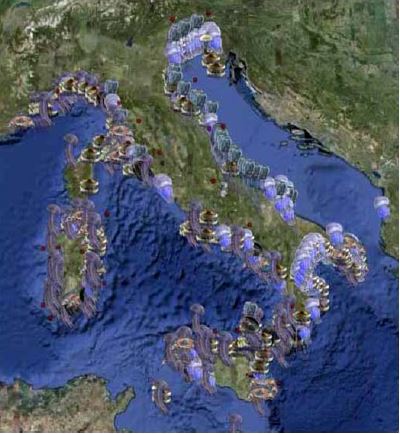3.3 Further studies on blooms
Citizen science is probably the best method to assess the presence of gelatinous blooms across large spaces, but further studies are of course needed to better understand the processes leading to these phenomena. Research projects on gelatinous plankton typically must involve the assessment of:
1. the genetic status of relevant species to evaluate genetic fluxes across different populations (e.g. Stopar et al., 2010) and to ascertain the mechanisms of colonization by NIS;
2. the position of the various species into food webs (what they eat, who eats them); 3. the physical conditions that are more conducive to proliferations;
4. the links between current regimes and jellyfish transport and accumulation; 5. the importance of benthic stages, when present;
6. the existence of natural products that might be used by humans (from food to drugs); 7. the impact on human health;
8. the impact on local economies (from fisheries to tourism).
Jellyfish outbreaks or even simple presences are almost impossible to forecast. During the Pelagia years, the abundance of this species gave the impression that it would have dominated the Mediterranean Sea for decades but, eventually, the blooms came to an end in a very abrupt way, being replaced by dinoflagellate blooms, at least in the Adriatic (Fig. 14).

Figure 22. Graphic representation of the presence of jellyfish along the Italian coast in the summer 2010. Pelagia dominates the western basin but it is absent from the Adriatic, where Rhizostoma and Carybdea are dominant (Boero, unpublished).
In the past, these outbreaks have been correlated to El Nino or to the North Atlantic oscillation, and, if this were the case also in this historical period, it might even be possible to attempt some prediction. The abundance of jellyfish in almost all the oceans of the world, and the persistence of the phenomenon, however, suggest that these correlations with periodic events are probably not so important, even if they have been so in the past.
The large scale citizen science study, covering the Adriatic, the Ionian, the Tyrrhenian and the Ligurian Seas, shows that species distribution can be very different in the various basins (Fig. 22), and such distributions are not consistent from year to year. If these events were driven by meteorological drivers (i.e. by the short-term expression of climatic conditions), it is clear that predictions are impossible, since we cannot predict the weather over the medium
long term. However, since the gelatinous plankters are transported by the currents, it might be possible to forecast that a bloom observed at a given part of the basin might be transported to another part of the basin by the prevailing currents.
During the citizen science study, the Meteomedusa web page showed the records of jellyfish along the Italian coast in almost real time. Those maps, of course, did not predict the future, but showed the present and gave an idea of jellyfish presence at a basin scale. The coupling of both current and wind regimes with the distribution of species at a given moment, might lead to give indications of possible future scenarios in the short term.